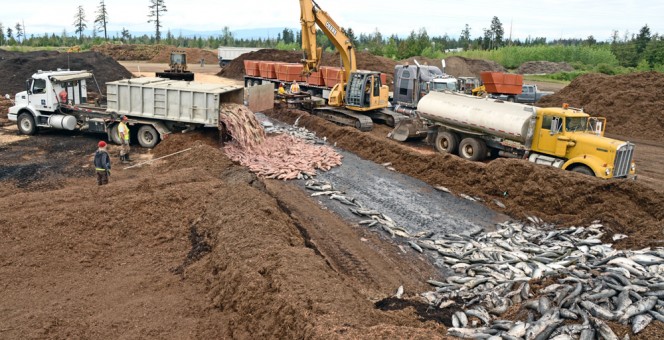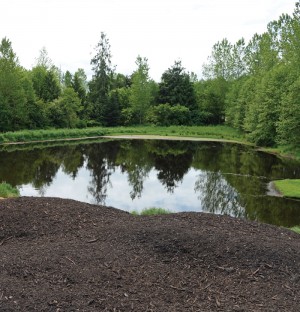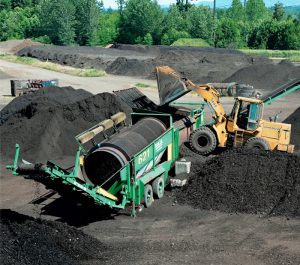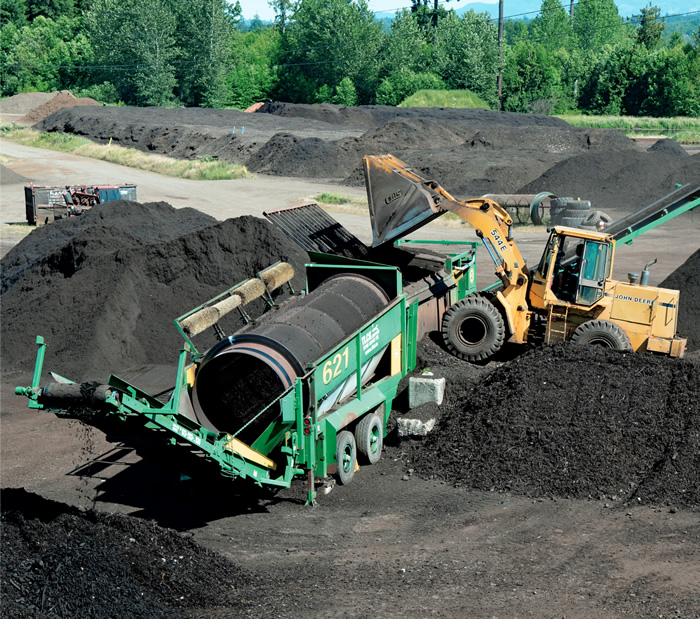Vancouver Island composting facility processes about 6,000 tons/year of wild and farmed salmon waste only a mile away from a popular golf course and high density retirement community.
Dan Emerson
BioCycle August 2015

Earthbank Resource Systems receives wild and farmed salmon processing waste (offal) as well as mortalities (left). Fish waste is blended with carbon, and placed into a “block” that is capped with a mixed blend of wood waste and partially cured compost. Photo courtesy of Earthbank Resource Systems
Vancouver Island, British Columbia (BC), on Canada’s southwest coast, has a number of distinctive traits. As the only part of Western Canada that is south of the 49th Parallel, it has the warmest climate in the country. Much of the island also has dry, rocky soil, leading some locals to refer to it as “The Rock.”
For Vancouver Island-based Earthbank Resource Systems Ltd., those factors have helped create a receptive market for high-quality, fish and wood-based compost. “High quality compost is an easy ‘sell’ on the island,” says Jessica Reid, Earthbank’s sales and marketing director. The island also provides an abundant supply of the raw material Earthbank uses to make its fish-based compost: both wild and farmed salmon waste from the area’s processors, and salmon that die before harvest.
In the late 1980s and early 1990s, as the salmon farming industry on the West Coast grew rapidly, so did the waste stream, leading to a provincial government ban on landfilling fish waste. The BC provincial government, through its Ministry of Environment, asked Earthbank to start handling both farmed and wild salmon waste for composting. Earthbank originally began composting fish and wood waste in the Comox Valley on the East Coast of Vancouver Island in 1991, and has been doing the same at its current location in Parksville, BC since 1996. The owner and founder of Earthbank Resource Systems, Terry Gay, has more than 30 years’ experience in composting various organic waste streams. Gay, a former organic farmer and sprout grower, was part owner and founder of Eatmore Sprouts Inc. and Earthbank Farm in the Courtenay, BC area from 1977 to 1991.
Gay also worked with a nonprofit organization known as the Demong Society, which was dedicated to promoting composting beginning in the early 1980s. The Demong Society was the first organization to compost sewage and a number of other organic waste materials in the Comox Valley that were, at the time, either dumped into Georgia Strait, or landfilled. The Demong project led directly to the Comox Valley District establishing the first successful sewage treatment and composting plant in BC, and also Gay launching a septage composting facility on Dove Creek Farm near Earthbank Farm. The farm evolved into Earthbank Resource Systems, and eventually into a fish composting operation exclusively. Gay began his composting operation on a 10-acre parcel that he still leases from a local farmer, and has since acquired more land adjacent to the site.

The operation has a series of about 10 strategically placed containment ponds. A side benefit of the ponds is a thriving bird habitat. Photo courtesy of Earthbank Resource Systems
Earthbank is the only fish composting operation on Vancouver Island regulated by the Regional District of Nanaimo, and as such must meet stringent environmental standards related to ground water testing and off-site odor control. “As the crow flies, we are just 2 kilometers (1.2 miles) away from a popular golf course and a high density, upper-middle class retirement community,” Reid notes, adding that to meet the standards, salmon waste “has to be handled very specifically. We have the opportunity to turn this quite volatile waste material into beautiful black soil amendment that works so well, customers come back year after year, including certified organic farmers.”
Composting Logistics
The operation has a series of about 10 strategically-placed containment ponds, along with a dozen monitoring wells with depths ranging from 12 to 70 feet to ensure the leachate does not reach groundwater. Those measures were proposed and accepted by the Regional District of Nanaimo, and have been successful over many years. With a total footprint of nearly 50 acres in size, a side-benefit has been development of “a thriving bird habitat in our back 40, with ducks, geese, eagles and other birds,” notes Reid.
At its composting site, Earthbank receives a combination of wild and farm salmon waste from two large local processing plants, charging tipping fees for drop-offs. Earthbank handles about 6,000 tons/year of fish waste, comprised of 70 to 80 percent offal, both wild and farmed salmon, and 20 to 30 percent farm mortalities (fish which die before harvest). It also receives and grinds about 6,000 tons/year of uncontaminated, land-clearing debris, which produces about 30,000 cubic yards (cy) of bulking material, and accepts some sawdust from local sawmills.

Compost is screened to three-eighth-inch minus, and marketed in bulk locally. Photo courtesy of Earthbank Resource Systems
The fish waste and wood are blended together in a preset formula that can vary depending on the specific wood waste and other factors. The mixed material is then formed into a “block” that is capped with a mixed blend of wood waste and partially cured compost to provide a biofilter for odor control of the “primary block”. As more fish waste is brought onto the site, more of the fish-wood blend is added to the preexisting block, until it reaches a predetermined size and/or time period. Then a new primary block is started.
The primary blocks sit untouched for a set period that is determined by the time of year. For example, they are not handled at all from April to October, to minimize odor during warm weather. After active composting, material is moved into secondary blocks that are turned several times over the next 12 months. If weather permits, secondary blocks are turned more frequently in the early spring, and late fall. “It’s very fluid and dynamic because we’re dealing with so many variables,” Reid says.
After about 18 months of primary and secondary block composting, the secondary blocks are broken down into windrows that can be turned frequently if necessary, since offsite odor during this stage is not a concern. The total number of turns can vary, with a minimum of 15 turns before the material is screened for use.
Equipment used in the composting operation are a combination of CAT and John Deere front loaders and excavators, as well as a Diamond Z grinder and McCloskey 621 Screener. Finished compost is screened to three-eighth inch minus, with the “overs” being reincorporated back into the composting process. “Nothing is wasted,” Reid notes. “Mother Nature does most of the work around here. We are just monitoring to ensure we are producing a fully-cured, high quality product.”
The operation produces in the range of 10,000 to 15,000 cy of finished product annually, which is distributed in bulk locally only on Vancouver Island. The compost has a nitrogen content of 1 to 2 percent, eliminating the need to add fertilizer. Earthbank sells the majority of its fish compost in bulk form to farmers and gardeners on Vancouver Island, and is sold out every year. The compost has an OMRI listing for use in certified organic food production on the island.
Since it began producing large amounts of fish compost in 1991, Earthbank has seen a steadily growing market. The company has had to do a certain amount of consumer education. “When we started, there was no fish compost, and we had to talk about not only what it is, but also how to use it and why it is so effective,” adds Reid, “including information on the potency of the compost, and its contaminant and pathogen-free state.”
Dan Emerson is a Contributing Editor to BioCycle.














